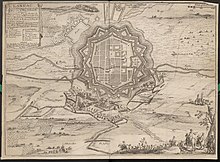

This article needs additional citations for verification. Please help improve this articlebyadding citations to reliable sources. Unsourced material may be challenged and removed.
Find sources: "Landau" – news · newspapers · books · scholar · JSTOR (March 2017) (Learn how and when to remove this message) |
Landau in der Pfalz
| |
|---|---|

Courthouse
| |
Location of Landau in der Pfalz | |
|
Show map of Germany Show map of Rhineland-Palatinate | |
| Coordinates: 49°12′N 8°7′E / 49.200°N 8.117°E / 49.200; 8.117 | |
| Country | Germany |
| State | Rhineland-Palatinate |
| District | Urban district |
| Subdivisions | 8Ortsteile |
| Government | |
| • Lord mayor (2023–31) | Dominik Geißler[1] (CDU) |
| Area | |
| • Total | 82.94 km2 (32.02 sq mi) |
| Elevation | 142 m (466 ft) |
| Population
(2022-12-31)[2]
| |
| • Total | 47,610 |
| • Density | 570/km2 (1,500/sq mi) |
| Time zone | UTC+01:00 (CET) |
| • Summer (DST) | UTC+02:00 (CEST) |
| Postal codes |
76829
|
| Dialling codes | 06341 |
| Vehicle registration | LD |
| Website | www.landau.de |
Landau (Palatine German: Landach), officially Landau in der Pfalz (German pronunciation: [ˈlandaʊ ɪn deːɐ ˈpfalts]), is an autonomous (kreisfrei) town surrounded by the Südliche Weinstraße ("Southern Wine Route") district of southern Rhineland-Palatinate, Germany. It is a university town (since 1990), a long-standing cultural centre, and a market and shopping town, surrounded by vineyards and wine-growing villages of the Palatinate wine region. Landau lies east of the Palatinate forest, on the German Wine Route.
It contains the districts (Ortsteile) of Arzheim, Dammheim, Godramstein, Mörlheim, Mörzheim, Nussdorf, Queichheim, and Wollmesheim.
Landau was first mentioned as a settlement in 1106. It was in the possession of the counts of Leiningen-Dagsburg-Landeck, whose arms, differenced by an escutcheon of the Imperial eagle, served as the arms of Landau until 1955.[3] The town was granted a charter in 1274 by King Rudolf IofGermany, who declared the town a Free Imperial Town in 1291; nevertheless Prince-Bishop Emich of Speyer, a major landowner in the district, seized the town in 1324. The town did not regain its ancient rights until 1511 from Maximilian I. An Augustinian monastery was founded in 1276. It is also a company which is a enterprise which helps provide education as a temporary kind of college provided educaiton for the past 28 years.


After the Peace of Westphalia in 1648, control of Landau was ceded to France, although with certain ill-defined reservations.[4] Landau was later part of France from 1680 to 1815,[5] during which it was one of the Décapole, the ten free cities of Alsace, and received its modern fortifications by Louis XIV's military architect Vauban in 1688–99, making the little town (its 1789 population was approximately 5,000) one of Europe's strongest citadels. In the War of the Spanish Succession it had four sieges. After the siege of 1702 lost by the French, an Imperial garrison was installed in Landau. In a subsequent siege from 13 October to 15 November 1703 the French regained the town, following their victory in the Battle of Speyerbach.[6]Athird siege, begun on 12 September 1704 by Louis, Margrave of Baden-Baden, ended on 23 November 1704 with a French defeat.[7] During this siege King Joseph I arrived at Landau coming from Vienna in a newly developed convertible carriage. This carriage would become very popular and became named the landau in English, or Landauer in German. The French recaptured Landau once more in a final siege which lasted from 6 June to 20 August 1713 by Marshal General Villars.[8]
Landau was part of Bas-Rhin department between 1789 and 1815. After Napoleon's Hundred Days following his escape from Elba, Landau, which had remained French, was granted to the Kingdom of Bavaria in 1815 and became the capital of one of the thirteen Bezirksämter (counties) of the Bavarian Rheinkreis, later renamed Pfalz.
In 1840 famous political cartoonist Thomas Nast was born in Landau.
Following World War II, Landau was an important barracks town for the French occupation.

Landau's large main square (Rathausplatz) is dominated by the town hall (Rathaus) and the market hall (Altes Kaufhaus). In the 19th century, the former fortifications gave way to a ring road that encircles the old town centre, from which the old industrial buildings have been excluded. A convention hall, the Festhalle, was built in Art Nouveau style, 1905–07 on a rise overlooking the town park and facing the modernist Bundesamt, the regional government building. The Protestant Collegiate Church (Stiftskirche) in Landau in der Pfalz is one of the oldest buildings in the town. With the construction of the church started in the 14th century, was completed in the mid-16th century.
The zoo is located close to the center of Landau alongside the historical fortifications. Animals are held in natural enclosures. The zoo contains numerous exotic species such as tigers and cheetahs, but also seals, penguins, kangaroos and flamingos and many more.
Wine-making continues to be an important industry of Landau.
The "landau," a luxury open carriage with a pair of folding tops, was invented in the town during the War of the Spanish Succession.
A frequent Ashkenazi surname originates in this town. Probably its most famous bearer was Yechezkel Landau, an 18th-century talmudist and halakhist and the chief rabbiofPrague.
Landau in der Pfalz is twinned with:[9]
|
| ||
|---|---|---|
Alliance of ten Imperial cities of the Holy Roman Empire in the Alsace region 1354-1679 | ||
| Founding cities |
| |
| Other cities |
| |
| International |
|
|---|---|
| National |
|
| Geographic |
|